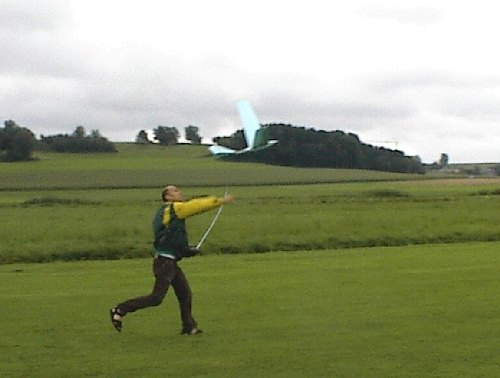Presentation of the aircrafts
The Truefly is not a full-sized aircraft yet. "Truefly" is the name of the
first scale model aircraft which is able to fly the way birds do, which is by
flapping its wings.
Invented in a laboratory or a research center ?

Neither one : its originator, Albert KEMPF, is neither an
engineer nor a researcher, just a fan. Surely, he is keen on aeronautics :
he can pilot gliders and helicopters, often goes
hand-gliding, is a really good model maker, and a fine
observer of nature, especially birds.
All this variety of knowledge was necessary to carry out the invention of
the Truefly.
This aircraft is the archievement of 10 years of observation, thinking
and work. It was built to show the public that it is possible to fly the way
birds do.
The aircrafts themselves :

In fact, now there are 2 different aircrafts really able to fly using this way of propulsion. Both are composed of relatively simple parts : a brace, some rods and some wing articulations.
The aircraft drafts are very simple, in contrast to the complex problem that was posed - it
required a huge amount of work and creativity.
The Trueflys are two simple two axis aircrafts (drift and depth). They are propelled by a small
electric motor. For transport, the wings can be taken apart in 2 pieces.
Technical data :
The first Truefly was built in 1998 and has a wingspan of 1m70.
The second aircraft is brand new (may 2000) and is a little bit smaller (wingspan: 1m20). It is an optimized version of the first one: more reliable and easier to manufacture. It is currently adjusted so that we should obtain a rectilinear flight and a better efficiency.
Here are the technical data corresponding to each Truefly:
| | |
| Truefly 1 | Truefly 2 |
| Wingspan | 1,66 m (5'5'') | 1,24 m (4'1'') |
| Weight | 1,4 kg (3.08 lb) | 440 gr (0.96 lb) |
| Charge alaire | 40 g/dm² (0.82 lb/ft²) | 22 g/dm² (0.45 lb/ft²) |
| Motor | format 580 | speed 280 |
| Accumulators | 10 of 500mA | 8 of 350mA |
| Flight duration | 3 min | more than 5 min |
| 2 axes à empennage | " classique " | " papillon " |
| Flap frequency | 3 fp/s | 2,8 fp/s |
| Date of the first flight | spring 98 | 06/18/00 |
The flight :
It has the same flight field as common leirsure aircraft.
The flight is smooth, and appears to onlookers like a large bird.
In spite of the wing flaps, the body follows a stable rectilinear
trajectory without any jerking motion (well.. at this time, this is true for the first Truefly
only, but it is soon going to be true for the second one as well !). The efficency of the flap makes the Truefly
maintain its flight level with less than half of the available power.


Currently, after many flights, we can affirm that the piloting of those aircrafts is
simple and tolerant. They can be piloted just like the 2 axis planes used for initiation.
The only thing that can disturb the habits of the pilot is the wing motion.
The landing is easy, but the bird tends to be long to land. And of course, there is no gear.

You can see videos and photos of the both model on this web site.
